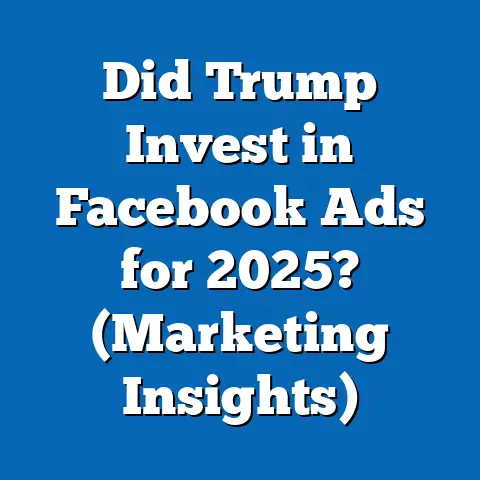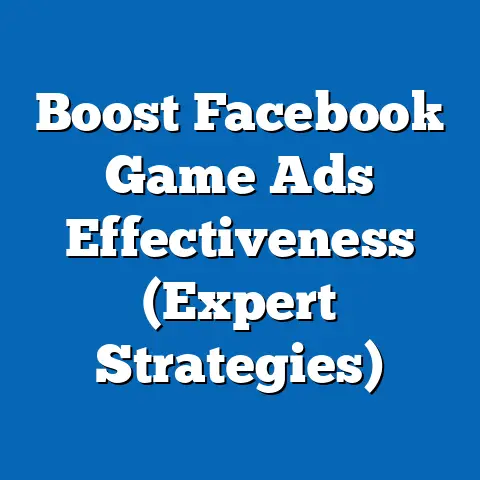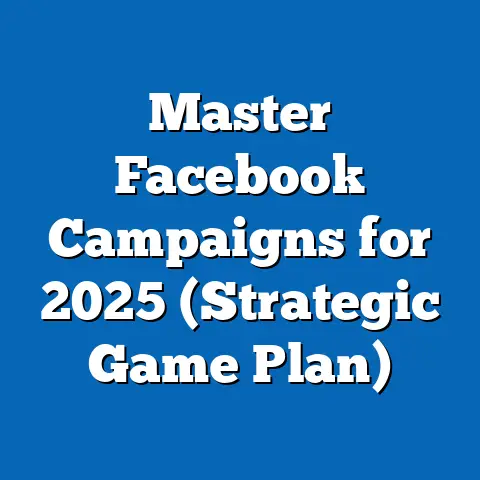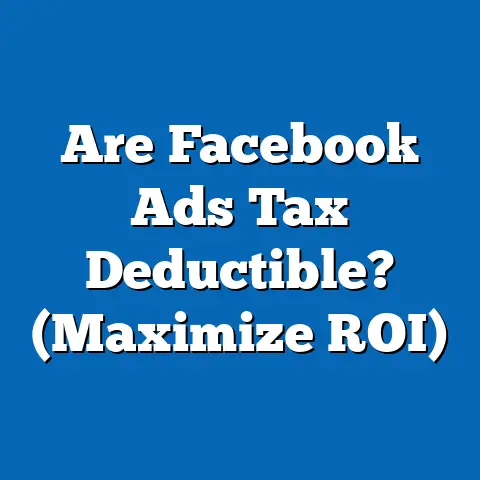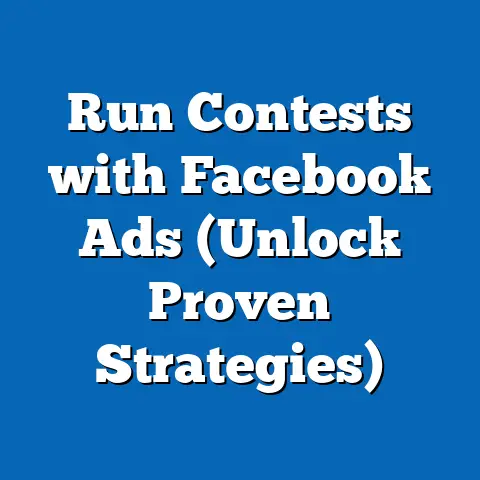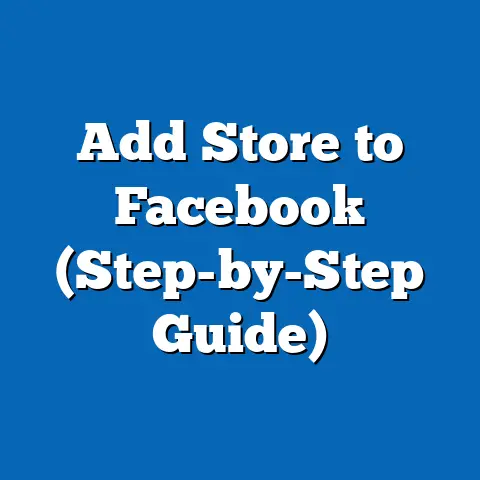Maximize Reach with Effective Facebook Ads (Proven Strategies)
Maximize Reach with Effective Facebook Ads: Proven Strategies
Facebook advertising is a beast, no doubt. I remember when I first started, I felt like I was throwing darts in the dark, hoping something would stick. But over time, I learned that with the right strategies, you can not only reach a massive audience but also connect with people who genuinely care about what you have to offer.
Introduction
In today’s world, sustainability isn’t just a buzzword; it’s a necessity. Consumers are increasingly aware of the impact their choices have on the planet, and they’re actively seeking out businesses that align with their values. This shift presents a unique opportunity for brands that embrace sustainability to connect with a highly engaged audience.
Digital marketing, and specifically Facebook ads, plays a crucial role in amplifying your message. It’s not enough to simply be sustainable; you need to show that you are. With the right approach, Facebook advertising can significantly enhance your reach, allowing you to connect with potential customers who are passionate about sustainability and eager to support businesses that share their values. Think of it as more than just selling a product; it’s about building a community.
Section 1: Understanding Facebook Ads
Facebook Ads isn’t just a platform; it’s a universe of potential customers. With billions of active users, Facebook offers unparalleled reach for businesses of all sizes. But simply being on Facebook isn’t enough. You need to understand the platform’s nuances to effectively connect with your target audience.
The Power of Facebook’s Audience
Facebook’s strength lies in its vast and diverse audience. From teenagers discovering the world to retirees staying connected with family, Facebook caters to a wide range of demographics, interests, and behaviors. This diversity allows you to precisely target your ideal customer, ensuring your message reaches the people most likely to engage with your brand.
I’ve seen firsthand how laser-focused targeting can transform a campaign. I once worked with a small, eco-friendly cleaning product company. Instead of broadly targeting “eco-conscious consumers,” we dug deep into their interests. We targeted people who followed specific environmental organizations, those who participated in local farmers’ markets, and even those who engaged with content about zero-waste living. The results were astounding. Their ad engagement soared, and their sales skyrocketed.
Types of Facebook Ads
Facebook offers a variety of ad formats to suit different objectives and target audiences. Here are a few common types:
- Image Ads: Simple, yet effective, image ads are ideal for showcasing your product or service with a visually appealing image and concise copy.
- Video Ads: Video ads are incredibly engaging and allow you to tell a story, demonstrate your product, or share a compelling message.
- Carousel Ads: Carousel ads allow you to showcase multiple images or videos in a single ad, making them perfect for highlighting different features of a product or telling a more detailed story.
- Collection Ads: Collection ads are designed for e-commerce businesses, allowing you to showcase a catalog of products in a visually appealing and easily shoppable format.
- Lead Ads: Lead ads are designed to capture leads directly within Facebook, making it easy for potential customers to sign up for your newsletter, request a quote, or learn more about your business.
Each ad type has its own unique advantages. Image ads are great for quick, visual impact, while video ads allow for deeper storytelling. Carousel ads are perfect for showcasing multiple products, and collection ads are ideal for driving e-commerce sales.
The Importance of Ad Placements
Where your ad appears on Facebook can significantly impact its reach and engagement. Facebook offers a variety of ad placements, including:
- Facebook Feed: The most common ad placement, appearing directly in users’ news feeds.
- Instagram Feed: Ads appear in users’ Instagram feeds, seamlessly blending in with organic content.
- Facebook Marketplace: Ads appear in the Facebook Marketplace, targeting users who are actively looking to buy or sell products.
- Facebook Stories: Ads appear between users’ stories, offering a visually engaging and immersive experience.
- Instagram Stories: Similar to Facebook Stories, ads appear between users’ Instagram stories.
- Audience Network: Ads appear on websites and apps outside of Facebook, extending your reach to a broader audience.
Choosing the right ad placement depends on your target audience and campaign objectives. For example, if you’re targeting a younger audience, Instagram Stories might be a better choice than the Facebook Feed.
Facebook Ads vs. Other Digital Advertising Methods
Facebook Ads offers several advantages over other digital advertising methods:
- Precise Targeting: Facebook’s detailed targeting options allow you to reach a highly specific audience based on demographics, interests, behaviors, and more.
- Measurable Results: Facebook provides comprehensive analytics and reporting tools, allowing you to track your ad performance and measure your ROI.
- Cost-Effectiveness: Compared to traditional advertising methods, Facebook Ads can be incredibly cost-effective, allowing you to reach a large audience on a relatively small budget.
- Flexibility: Facebook offers a variety of ad formats and placements, allowing you to tailor your campaigns to different objectives and target audiences.
According to recent statistics, Facebook Ads boasts an average click-through rate (CTR) of around 0.9%, which is significantly higher than the average CTR for display ads on other platforms. Additionally, businesses report an average return on ad spend (ROAS) of $8.71 for every $1 spent on Facebook Ads.
Takeaway: Understanding the fundamentals of Facebook Ads, including its audience, ad types, placements, and advantages, is crucial for maximizing your reach and achieving your advertising goals.
Next Step: Familiarize yourself with the Facebook Ads Manager and explore the different ad formats and targeting options available.
Section 2: Crafting Compelling Ad Content
Content is king, and that’s especially true when it comes to Facebook Ads. No matter how precisely you target your audience, if your ad content isn’t engaging and relevant, it won’t resonate with your target audience.
The Power of Engaging Content
Engaging content is what captures attention and drives action. In a world saturated with information, your ad needs to stand out from the noise and immediately grab the viewer’s attention. Think about the ads that have stuck with you – what made them memorable? Was it the captivating visuals, the compelling story, or the irresistible offer?
I once worked with a local bakery that was struggling to attract new customers. Their initial ads were generic and uninspired, simply showcasing pictures of their pastries with a basic description. We decided to revamp their strategy and focus on storytelling. We created a series of video ads that told the story of the bakery, highlighting the passion and dedication of the bakers, the quality of the ingredients, and the joy that their pastries brought to the community. The response was incredible. People connected with the story, and the bakery saw a significant increase in foot traffic and sales.
Writing Compelling Ad Copy
Your ad copy is your opportunity to speak directly to your target audience and persuade them to take action. Here are a few tips for writing compelling ad copy:
- Know Your Audience: Understand their needs, desires, and pain points. Speak directly to their interests and address their concerns.
- Use Strong Calls-to-Action (CTAs): Tell people exactly what you want them to do. Use clear and concise CTAs like “Shop Now,” “Learn More,” “Sign Up Today,” or “Get a Free Quote.”
- Highlight Benefits, Not Just Features: Focus on the benefits your product or service provides, rather than simply listing its features. Explain how it will improve their lives or solve their problems.
- Keep it Concise: People have short attention spans. Get to the point quickly and avoid unnecessary jargon or fluff.
- Use Storytelling: Tell a compelling story that resonates with your audience and connects them to your brand on an emotional level.
The Importance of Visuals
Visuals are crucial for capturing attention on Facebook. High-quality images and videos can significantly improve your ad’s performance and engagement.
- Use High-Quality Images: Choose images that are visually appealing, relevant to your product or service, and optimized for Facebook’s ad specifications.
- Create Engaging Videos: Video ads are incredibly effective for telling stories, demonstrating products, and capturing attention. Keep your videos short, engaging, and visually appealing.
- Use Eye-Catching Graphics: Incorporate eye-catching graphics and animations to make your ads stand out from the crowd.
Examples of Successful Sustainability Ad Campaigns
There are countless examples of brands that have successfully communicated sustainability messages through Facebook Ads. Here are a few:
- Patagonia: Known for its commitment to environmental activism, Patagonia uses Facebook Ads to promote its sustainable practices, such as using recycled materials and supporting environmental organizations.
- Allbirds: This sustainable shoe brand uses Facebook Ads to highlight its eco-friendly materials and manufacturing processes.
- Beyond Meat: This plant-based meat company uses Facebook Ads to promote its sustainable and ethical food choices.
These brands understand the importance of authenticity and transparency. They don’t just talk about sustainability; they demonstrate it through their actions and their advertising.
Takeaway: Crafting compelling ad content is essential for capturing attention, driving engagement, and ultimately achieving your advertising goals. Focus on understanding your audience, writing persuasive copy, and using high-quality visuals to create ads that resonate with your target audience.
Next Step: Review your existing ad content and identify areas for improvement. Experiment with different ad copy, visuals, and CTAs to see what resonates best with your audience.
Section 3: Targeting the Right Audience
Targeting is the superpower of Facebook advertising. It allows you to reach a specific group of people with your message, ensuring that your ads are seen by those most likely to be interested in your product or service.
The Importance of Audience Targeting
Imagine shouting into a crowded stadium. You might reach a lot of people, but most of them won’t be interested in what you have to say. Now imagine speaking to a small group of people who are specifically interested in the topic you’re discussing. Your message is far more likely to resonate with them. That’s the power of audience targeting.
I’ve seen firsthand how effective targeting can transform a failing campaign into a roaring success. I once worked with a local organic farm that was struggling to attract new customers through Facebook Ads. Their initial targeting was broad, targeting anyone who lived within a certain radius of the farm. We decided to refine their targeting and focus on people who were specifically interested in organic food, sustainable living, and local agriculture. We targeted people who followed organic food blogs, those who shopped at local farmers’ markets, and even those who participated in community gardens. The results were dramatic. Their ad engagement soared, and they saw a significant increase in sales.
Facebook’s Audience Targeting Tools
Facebook offers a variety of audience targeting tools to help you reach the right people:
- Custom Audiences: Custom Audiences allow you to target people who have already interacted with your business, such as website visitors, email subscribers, or customers.
- Lookalike Audiences: Lookalike Audiences allow you to target people who are similar to your existing customers, expanding your reach to a new audience of potential customers.
- Interest-Based Targeting: Interest-based targeting allows you to target people based on their interests, hobbies, and activities.
- Demographic Targeting: Demographic targeting allows you to target people based on their age, gender, location, education, and other demographic factors.
- Behavioral Targeting: Behavioral targeting allows you to target people based on their online behaviors, such as their purchase history, browsing habits, and device usage.
Identifying and Understanding Your Target Audience
Before you can effectively target your audience, you need to understand who they are. Consider the following factors:
- Demographics: Age, gender, location, education, income, etc.
- Psychographics: Values, attitudes, interests, lifestyle, etc.
- Behaviors: Purchase history, browsing habits, online activities, etc.
Talk to your existing customers, conduct market research, and analyze your website analytics to gain a deeper understanding of your target audience.
Case Studies of Successful Targeting
There are countless examples of brands that have successfully reached their target audiences through strategic targeting. Here are a few:
- A clothing brand targeting environmentally conscious millennials: They might target people who follow sustainable fashion blogs, shop at eco-friendly stores, and participate in environmental activism.
- A local organic farm targeting health-conscious families: They might target people who are interested in organic food, healthy recipes, and local agriculture.
- A renewable energy company targeting homeowners: They might target people who own their homes, are interested in energy efficiency, and have expressed interest in solar panels or other renewable energy technologies.
Takeaway: Targeting the right audience is crucial for maximizing your reach and achieving your advertising goals. Utilize Facebook’s audience targeting tools to reach a specific group of people who are most likely to be interested in your product or service.
Next Step: Define your target audience by considering their demographics, psychographics, and behaviors. Experiment with different targeting options to see what resonates best with your audience.
Section 4: Leveraging Facebook Ad Features
Facebook Ads is more than just a platform for creating and running ads; it’s a powerful suite of tools designed to help you optimize your campaigns and achieve your advertising goals.
A/B Testing
A/B testing, also known as split testing, allows you to compare different versions of your ad to see which performs best. You can test different headlines, images, ad copy, CTAs, and targeting options to identify the most effective combination.
I can’t stress enough how important A/B testing is. I’ve seen campaigns completely transformed by simply tweaking a headline or changing an image. It’s a constant process of experimentation and optimization.
Retargeting
Retargeting allows you to show ads to people who have already interacted with your business, such as website visitors, email subscribers, or customers. This is an incredibly effective way to re-engage potential customers and drive conversions.
Think about it: someone visits your website, browses your products, but doesn’t make a purchase. They’re clearly interested in what you have to offer. Retargeting allows you to remind them of your products and encourage them to complete their purchase.
Facebook Pixel
The Facebook Pixel is a snippet of code that you place on your website to track conversions, optimize ads, and build targeted audiences. It allows you to see how people interact with your website after clicking on your Facebook ad.
The Pixel is essential for tracking your ad performance and understanding how your ads are driving conversions. It also allows you to build Custom Audiences based on website visitors and retarget them with relevant ads.
Analytics and Insights
Facebook provides comprehensive analytics and reporting tools that allow you to track your ad performance and measure your ROI. You can track metrics like reach, impressions, clicks, conversions, and cost per conversion.
Analyzing your ad performance is crucial for identifying areas for improvement and optimizing your campaigns. Pay attention to metrics like CTR, conversion rate, and cost per conversion to see what’s working and what’s not.
Takeaway: Leveraging Facebook’s ad features, such as A/B testing, retargeting, the Facebook Pixel, and analytics, is essential for optimizing your campaigns and maximizing your reach.
Next Step: Implement the Facebook Pixel on your website and start tracking your ad performance. Experiment with A/B testing to optimize your ad copy, visuals, and targeting options.
Section 5: Budgeting and Bidding Strategies
Budgeting and bidding are two critical components of a successful Facebook ad campaign. Understanding how to allocate your budget and choose the right bidding strategy can significantly impact your reach and ROI.
The Importance of Budgeting
Budgeting is the process of allocating your advertising budget across different campaigns, ad sets, and ads. A well-defined budget ensures that you have enough funds to reach your target audience and achieve your advertising goals.
I always recommend starting with a smaller budget and gradually increasing it as you see positive results. This allows you to test different strategies and optimize your campaigns without risking a large amount of money.
Bidding Strategies
Facebook offers a variety of bidding strategies to help you control your ad spend and achieve your campaign objectives. Here are a few common bidding strategies:
- Cost Per Click (CPC): You pay each time someone clicks on your ad. This is a good strategy if your goal is to drive traffic to your website.
- Cost Per Thousand Impressions (CPM): You pay for every 1,000 impressions your ad receives. This is a good strategy if your goal is to increase brand awareness.
- Cost Per Acquisition (CPA): You pay each time someone takes a specific action, such as making a purchase or signing up for a newsletter. This is a good strategy if your goal is to drive conversions.
- Automated Bidding: Facebook automatically sets your bids to maximize your results within your budget. This is a good strategy if you’re new to Facebook Ads or don’t have the time to manually manage your bids.
The best bidding strategy depends on your campaign objectives and target audience.
Setting Daily or Lifetime Budgets
Facebook allows you to set either a daily budget or a lifetime budget for your campaigns.
- Daily Budget: The average amount you’re willing to spend each day on your ad.
- Lifetime Budget: The total amount you’re willing to spend on your ad over its entire duration.
Setting a daily budget is a good strategy if you want to run your ad continuously. Setting a lifetime budget is a good strategy if you want to run your ad for a specific period of time.
Takeaway: Budgeting and bidding are crucial for maximizing your reach and ROI on Facebook Ads. Define your budget based on your advertising goals and choose the right bidding strategy to achieve your campaign objectives.
Next Step: Determine your advertising budget and choose the appropriate bidding strategy for your campaigns. Monitor your ad spend and adjust your budget and bids as needed to optimize your results.
Conclusion
Maximizing reach with effective Facebook Ads requires a strategic approach that combines compelling content, precise targeting, and a deep understanding of the platform’s features. By crafting engaging ad content, targeting the right audience, leveraging Facebook’s ad features, and implementing effective budgeting and bidding strategies, you can significantly increase your reach and achieve your advertising goals.
Remember, Facebook advertising is an ongoing process of experimentation and optimization. Don’t be afraid to try new things, test different strategies, and learn from your results.
And most importantly, consider how your advertising efforts can not only benefit your bottom line but also contribute to a more sustainable future. By promoting sustainable practices and supporting businesses that align with your values, you can make a positive impact on the world.
So, what are you waiting for? Start applying these strategies in your next Facebook ad campaign and see the results for yourself! I’m confident that with the right approach, you can unlock the power of Facebook advertising and achieve your business goals while contributing to a more sustainable future.

